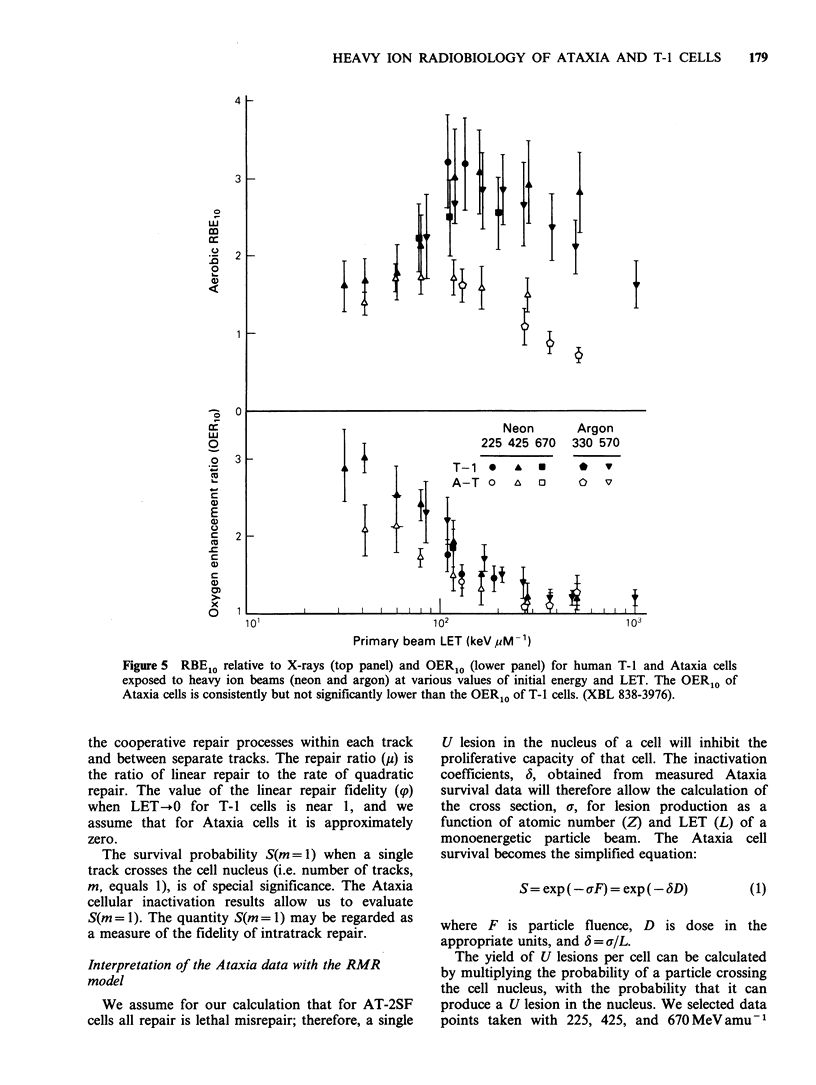Abstract
We have studied the radiation dose responses of two human fibroblast lines: cells from a patient with Ataxia telangiectasia (AT-2SF) and an established line of human T-1 cells. Aerobic and hypoxic 225 kVp X-ray survival curves were used as controls to the heavy ion exposures. Nearly monoenergetic accelerated neon and argon ions were used at the Berkeley Bevalac with various residual range values. The LET of the particles varied from 30 keV microns-1 to over 1,000 keV microns-1. All Ataxia survival curves were exponential functions of the dose. Their radiosensitivity reached peak values at 100-200 keV microns-1. Human T-1 cells have effective sublethal damage repair as has been evidenced by split dose experiments, and they are much more resistant to low LET than to high LET radiation. At high LET their radiosensitivity approached that of the Ataxia cells. The repair-misrepair model has been used to interpret these results. According to this model, the molecular repair processes culminate either in eurepair or in misrepair. We have obtained mathematical expressions that describe the cross sections and inactivation coefficients for both human cell lines as a function of the LET and the type of particle used. We assume that the lesions induced in T-1 and Ataxia cells are qualitatively similar and that each cell line attempts to repair these lesions. The result in most irradiated Ataxia cells, however, is either lethal misrepair or incomplete repair leading to cell death. T-1 cells have efficient repair mechanisms at low LET, and the repair-misrepair model suggests that at high LET the T-1 cells can still efficiently repair individual lesions, but that as the lesions become closely spaced along the tracks, the probability of misrepair increases.
Full text
PDF










Selected References
These references are in PubMed. This may not be the complete list of references from this article.
- Alper T., Bryant P. E. Reduction in oxygen enhancement ratio with increase in LET: tests of two hypotheses. Int J Radiat Biol Relat Stud Phys Chem Med. 1974 Sep;26(3):203–218. doi: 10.1080/09553007414551171. [DOI] [PubMed] [Google Scholar]
- Arlett C. F., Priestley A. Defective recovery from potentially lethal damage in some human fibroblast cell strains. Int J Radiat Biol Relat Stud Phys Chem Med. 1983 Feb;43(2):157–167. doi: 10.1080/09553008314550171. [DOI] [PubMed] [Google Scholar]
- Blakely E. A., Tobias C. A., Yang T. C., Smith K. C., Lyman J. T. Inactivation of human kidney cells by high-energy monoenergetic heavy-ion beams. Radiat Res. 1979 Oct;80(1):122–160. [PubMed] [Google Scholar]
- Fornace A. J., Jr, Little J. B. Normal repair of DNA single-strand breaks in patients with ataxia telangiectasia. Biochim Biophys Acta. 1980 May 30;607(3):432–437. doi: 10.1016/0005-2787(80)90153-7. [DOI] [PubMed] [Google Scholar]
- Furcinitti P. S. The potentiation by caffeine of X-ray damage to cultured human skin fibroblasts from normal subjects and ataxia-telangiectasia patients. Radiat Res. 1983 Jul;95(1):197–204. [PubMed] [Google Scholar]
- Ngo F. Q., Blakely E. A., Tobias C. A. Sequential exposures of mammalian cells to low- and high-LET radiations. I. Lethal effects following X-ray and neon-ion irradiation. Radiat Res. 1981 Jul;87(1):59–78. [PubMed] [Google Scholar]
- Painter R. B. Are lesions induced by ionizing radiation direct blocks to DNA chain elongation? Radiat Res. 1983 Aug;95(2):421–426. [PubMed] [Google Scholar]
- Painter R. B., Young B. R. Radiosensitivity in ataxia-telangiectasia: a new explanation. Proc Natl Acad Sci U S A. 1980 Dec;77(12):7315–7317. doi: 10.1073/pnas.77.12.7315. [DOI] [PMC free article] [PubMed] [Google Scholar]
- Pettersen E. O., Christensen T., Bakke O., Oftebro R. A change in the oxygen effect throughout the cell-cycle of human cells of the line NHIK 3025 cultivated in vitro. Int J Radiat Biol Relat Stud Phys Chem Med. 1977 Feb;31(2):171–184. doi: 10.1080/09553007714550191. [DOI] [PubMed] [Google Scholar]
- Taylor A. M., Harnden D. G., Arlett C. F., Harcourt S. A., Lehmann A. R., Stevens S., Bridges B. A. Ataxia telangiectasia: a human mutation with abnormal radiation sensitivity. Nature. 1975 Dec 4;258(5534):427–429. doi: 10.1038/258427a0. [DOI] [PubMed] [Google Scholar]


